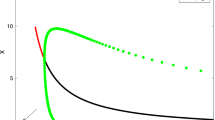Abstract.
We present a competition model of tumor growth that includes the immune system response and a cycle-phase-specific drug. The model considers three populations: Immune system, population of tumor cells during interphase and population of tumor during mitosis. Delay differential equations are used to model the system to take into account the phases of the cell cycle. We analyze the stability of the system and prove a theorem based on the argument principle to determine the stability of a fixed point and show that the stability may depend on the delay. We show theoretically and through numerical simulations that periodic solutions may arise through Hopf Bifurcations.
Similar content being viewed by others
References
Hardman, J., Linbird, L.: Goodman and Gilman's The Pharmacological basis of therapeutics. Mc Graw Hill, Health Profesion Division, 9 edition, 1996
Panetta, J.C., Adam, J.: A mathematical model of cycle-specific chemotherapy. Mathl. Compt. Modeling 22, 67–82 (1995)
Kirschner, D., Panetta, J.: Modeling immunotherapy of the tumor-immune interaction. J. Math. Biol. 37, 235–252 (1998)
Kuznetsov, V., Makalkin, I., Taylor, M., Perelson, A.: Nonlinear dynamics of immunogenic tumors: parameter estimation and global bifurcation analysis. Bull. Math. Biol. 56, 295–321 (1994)
Baker, C.T.H., Bocharov, G.A., Paul, C.A.H., Rihan, F.A.: Modeling and analysis of time-lags in some basic patterns of cell proliferation. J. Math. Biol. 37, 341–371 (1998)
Knolle, H.: Cell Kinetic Modeling and the Chemotherapy of Cancer. volume 75 of Lecture Notes in Biomathematics. Springer-Verlag, 1988
Eisen.: Mathematical Models in Cell Biology and Cancer Chemotherapy. volume 30 of Lecture Notes in Biomathematics, Springer-Verlag 1979
Tubiana, M., Malaise, E.: Comparison of cell proliferation kinetics in human and experimental tumors: response to irradiation. Cancer Treatment Reports 60, 1887–1895 (1976)
Birkhead, B., Rankin, E., Gallivan, S., Dones, L., Rubens, R.: A mathematical model of the development of drug resistance to cancer chemotherapy. Eur. J. Cancer Clin. Oncol. 23, 1421–1427 (1987)
de Pillis, L., Radunskaya, A.: A mathematical tumor model with immune resistance and drug therapy: an optimal control approach. J. Theor. Med. to appear 2003
Panetta, J.: A mathematical model of periodically pulsed chemotherapy: Tumor Metastasis in a competitive environment. Bull. Math. Biol. 58, 425–447 (1996)
Hart, D., Shochat, E., Agur, Z.: The growth law of primary breast cancer as inferred from mammography screening trials data. Br. Cancer 78, 382–387 (1998)
Norton, L., Simon, R.: Predicting the course of gompertzian growth. Nature 264, 542–545 (1976)
Norton, L.: A gompertzian model of human breast cancer growth. Cancer Res. 48, 7067–7071 (1988)
Villasana, M., Ochoa, G.: An optimal control problem for cancer cycle-phase-specific chemotherapy, to appear, IEEE TEC Journal, 2004
Steel, G.: Cell los as a factor in the growth rate of human tumours. Europ. J. Cancer 3, 381–387 (1967)
Zagury, D., Bernard, J., Jeannesson, P., Thiernesse, N., Cerottini, J.: Studies on the mechanism of T-cell mediated lysis at the single effector cell level. The J. Immunol. 123(4), 1604–1609 (1979)
Garcia-Peñarrubia, P., Bankhurst, A.D.: Kinetic analysis of effector cell recycling and effector-target binding capacity in a model ofcell-mediated cytotoxicity. J. Immunol. 143, 2101–2111 (1989)
Robertson, M.J., Williams, B.T., Christopherson, K.II., Brahmi, Z., Hromas, R.: Regulation of human natural killer cell migration and proliferation by the exodus subfamily of cc chemokines. Cellular Immunol. 199, 8–14 (2000)
Jondal, M., Ullberg, M., Merrill, J.: Interferon-induced nk augmentation in humans. an analysis of target recognition, effector cell recruitment and effector cell recycling. Scand. J. Immunol. 14, 285–292 (1981)
Petersson, E., Hedlund, G.: Proliferation and Differentiation of alloselective nk cellsafter alloimmunization evidence for an Adaptive nk response. Cellular Immunol. 197, 10–18 (1999)
Baserga, R.: editor. The Cell Cycle and Cancer. volume 1 of The Biochemistry of Disease A Molecular Approach to Cell Pathology, pages 358–387. Marcel Dekker, 1971
Bellman, R., Cooke, K.: Differential-Difference Equations. Academic Press, 1963
Hale, J., Verduyn Lunel, S.: Introduction to Functional Differential Equations, volume 99 of Applied Mathematical Sciences. Springer-Verlag, 1993
Mahaffy, J.: A test for stability of linear differential equations. Quart. Appl. Math. 40, 193–202 (1982)
Cooke, K., van den Driessche, P.: On the zeroes of some transcendental equations. Funkcialaj Ekvacioj 29, 77–90 (1986)
Bo, H.: To determine that all the roots of a trascendental polynomial have negative real parts. Chinese Ann. Math. 3, 373–392 (1997)
Thomlinson, R.: Measurement and management of carcinoma of the breast. Clin. Radiol. 33, 481–492 (1982)
Shampine, L.F., Thompson, S.: Solving ddes with Matlab http://www.runet.edu/~thompson/webddes/index.html
Afenya, E., Bentil, D.: Some perspectives on modeling leukemia. Math. Biosci. 150, 113–130 (1998)
Mahaffy, J.: Periodic solutions for certain protein models. J. Math. Anal. Appl. 74, 72–105 (1980)
Author information
Authors and Affiliations
Corresponding author
Additional information
Send offprint requests to: Minaya Villasana
Rights and permissions
About this article
Cite this article
Villasana, M., Radunskaya, A. A delay differential equation model for tumor growth. J. Math. Biol. 47, 270–294 (2003). https://doi.org/10.1007/s00285-003-0211-0
Received:
Revised:
Published:
Issue Date:
DOI: https://doi.org/10.1007/s00285-003-0211-0




